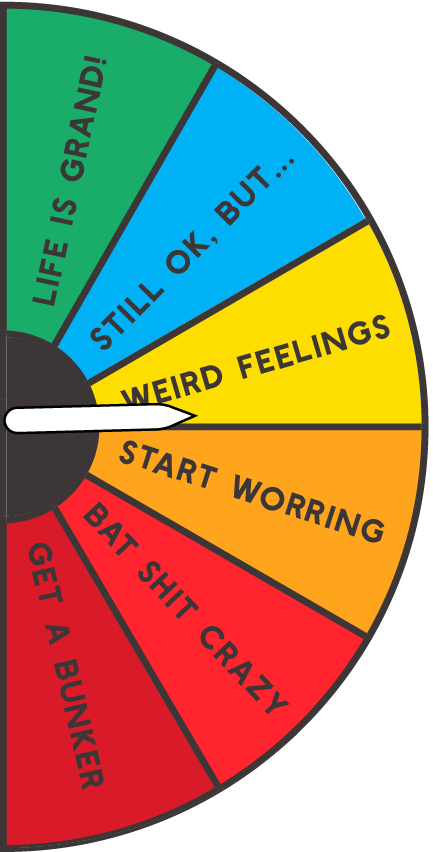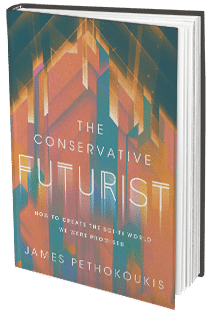Volcanoes are erupting in The Philippines, but on-fire Australia received some welcome rain. The Iran war cries have been called off and The Donald’s military powers are about to be hamstrung by the Senate. Meanwhile, his impeachment trial is starting, and we’re all on Twitter for a front-row seat.
What Could Go Right? Natural disasters are much less disastrous
We’re better at dealing with them, and fewer people are dying as a result.
This is our weekly newsletter, What Could Go Right? Sign up here to receive it in your inbox every Thursday at 5am ET. You can read past issues here.
Season 5 of What Could Go Right? the podcast began yesterday! In our first episode, we chat about all the progress news we missed over our break, from the adoption of sexual assault kit tracking systems across the United States to cleaning up space debris. Listen here.
Natural disasters are much less disastrous
Natural disasters are a frequent feature of news coverage. Because the suffering they cause is highly visual, they are easy to remember: we can easily recall recent stories on floods, landslides, and wildfires, and probably even specific photos and videos that were published with them. Especially now, with climate change such a dominant narrative, our brains are primed to pay extra attention.
All this naturally leads people into the assumption that we’re worse off now than we have been in the past when it comes to how deadly natural disasters are. The opposite is true, however.
Whereas over one million people used to die annually in the early and mid-1900s from natural disasters, post-2010 that number is 10–20,000. In 2022 and 2023, however, it was higher, at 60–70,000.
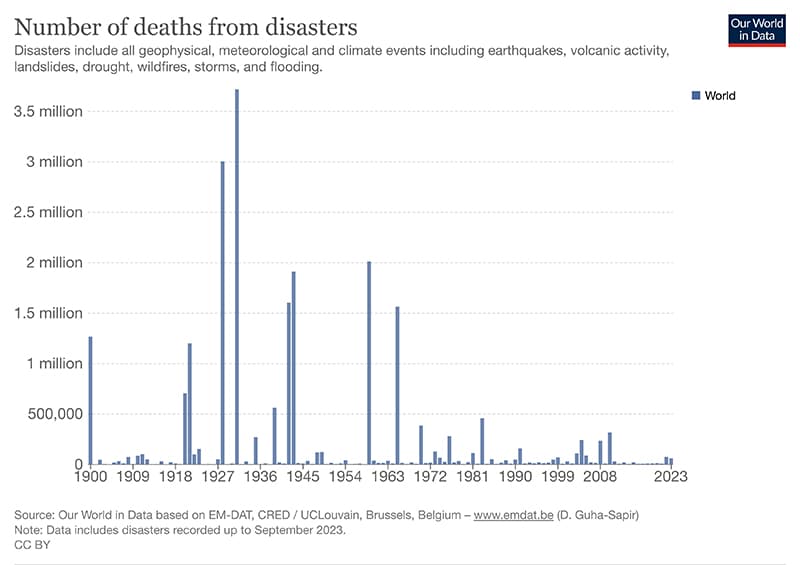
If we take the massive growth of the human population during this time into account, the effect is even more striking. While the chart above measures pure numbers—how many people die each year—the one below measures the death rate, commonly done as the number of deaths per 100,000 people.
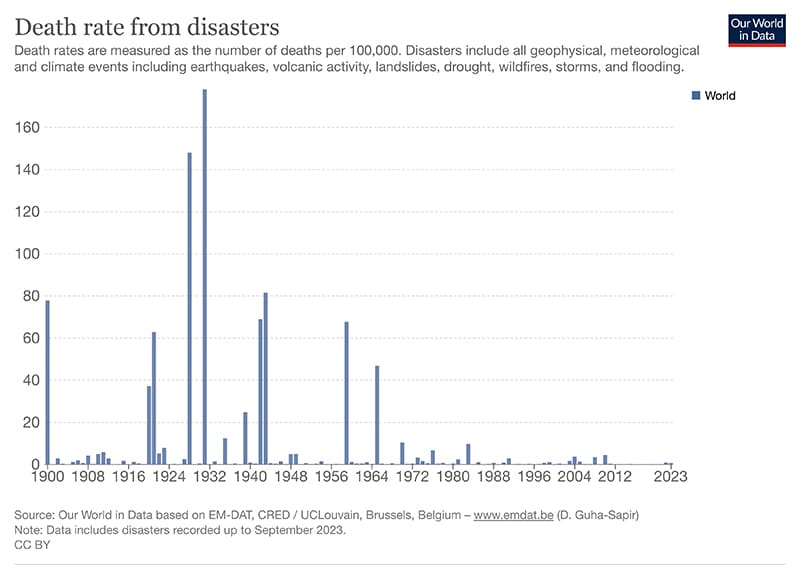
People die at far lower rates now not because natural disasters happen less often or are less powerful. Humans have simply become much better equipped at dealing with them. We have, as Our World in Data summarizes, earlier warnings, more resilient infrastructure, and better emergency preparedness and response systems. Think about seismic codes for buildings, for example, which weren’t a thing until the 1920s. Or the phones we have today, on which governments blare out warnings about storms or fires.
The kinds of natural disasters that are most deadly have also changed. The majority of deaths used to come from droughts and floods, which would cause famines. Famines these days are linked to regional conflict, not agricultural conditions, explains Our World in Data.
Now, the highest numbers of deaths come from earthquakes and extreme temperatures. In the 2020s (so far, anyway), those rates were .18 and .22 per 100,000 people, respectively. Another way to put that is about one person per every half million.
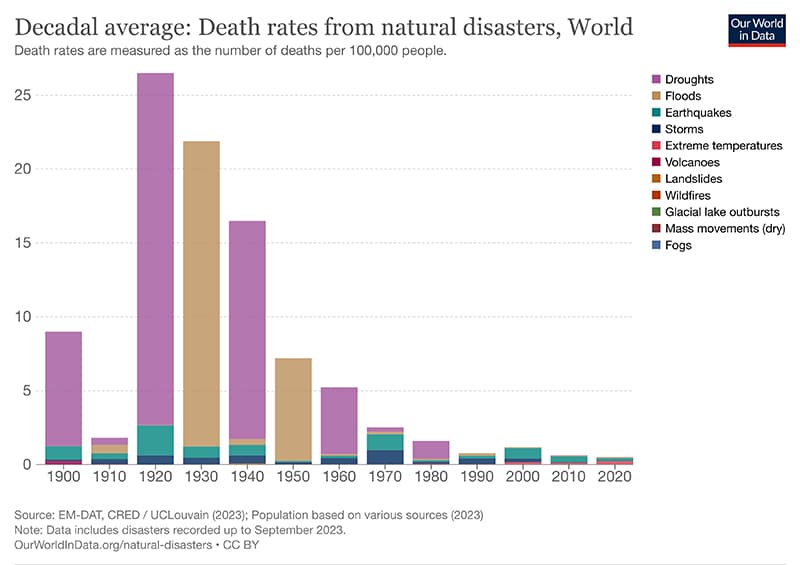
I am sure you’re asking, but what about climate change? Scientists have only recently begun studying whether there are links between earthquakes and the climate. None have been discovered that would trigger more or larger earthquakes of the kind that cause mass death, like the 2010 one in Haiti. So the name of the game here remains improving the four things in the list above—warnings, infrastructure, and emergency and response systems—and ensuring all nations have them.
Early warnings for earthquakes has been a hard nut to crack. There is some new evidence that deep-learning systems could better predict earthquakes and their aftershocks. There hasn’t been a breakthrough that would lead to the kind of useful forecasting that is done on extreme weather—think of all the information that is played on TV when a hurricane is about to land—but that would be the Holy Grail. AI is also helping forecast hurricanes faster and sometimes better.
As for extreme temperatures, this is one reason why the climate transition is so important. Currently, more people die from cold than from heat. But in a hotter world, it’s likely that while some cold-related deaths will be prevented, more heat-related ones will occur, for a net result of more people dying. (Climate scientist Andrew Dessler has a great three-part post on that here.)
Floods, droughts, and storms were the next highest causes of death from natural disasters in the 2010s and 20s. Per the Intergovernmental Panel on Climate Change, they haven’t yet seen an impact from climate change on the prevalence or intensity of all three, though they peg the odds of more droughts from a lack of soil moisture as 50-50. Prevailing knowledge indicates that climate change, if left unattended, could worsen these events, however.
Long story short, we have already created a world that has cut down greatly on life lost from natural disasters. There is likely a certain spot where humans will have reached the limits of our ability to save lives from forces outside of our control. But we’re not there yet. Even more progress means preventing climate change risks—especially as those are within our control—and bringing all nations to the level of advanced ones, so the ripple effects of natural disasters are maximally contained.
Not easy, but also not outside what is possible.
Quick hits
- We’re surrounded by space trash, and who is going to do anything about it? The Federal Communications Commission, that’s who. For the first time, they just fined a company, Dish Network, for not picking up the trash left behind by one of its satellites.
- How much has your country changed since you were born? I had so much fun with this new tool from Human Progress, where you can insert a year and a nation and see progress—or regress—on income levels, infant survival, democratic norms, and more.
- If you missed our event on surveillance and digital privacy with partners Zocalo Public Square and the ACLU of Southern California, you can watch the lively discussion here.
- Two public health notables: the scientists who did the research behind mRNA vaccines have won the Nobel Prize, and the World Health Organization has approved a second, cheaper malaria vaccine that can meet current demand for it.
Below in the links section, plastic-eating bacteria, teeth-growing drugs, gender-equal countries, and more.
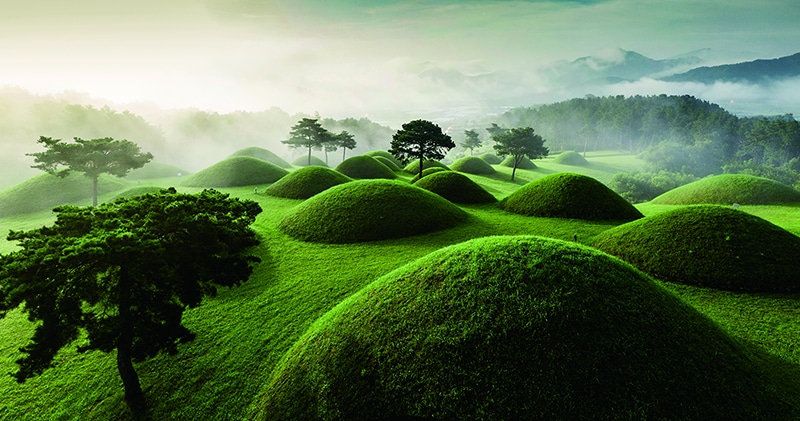
What Could Go Right? S5 E1
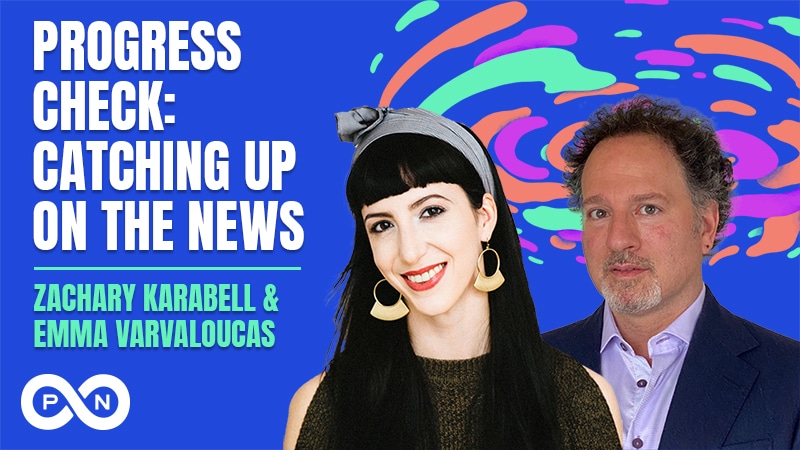
Is mental health worsening across generations? Has criminal justice reform actually worked? And are we ready for the first mass produced humanoid robots? “What Could Go Right?” hosts Zachary Karabell, founder of The Progress Network, and Emma Varvaloucas, executive director of The Progress Network, take a look at the progress that has been made since last season. | Listen to the episode
Progress, Please
(Found good news? Tweet at us @progressntwrk or email.)
Other good stuff in the news 🦷
Energy & Environment:
- Climate action game changers: The solar story | The World Bank
- Renewable energy champion Kenya plans Africa’s biggest wind farm | Bloomberg
- The plastic-eating bacteria that could change the world | The Guardian
Public Health:
- How one patient went off dialysis—and others can too | Stat News
- Japan pharma startup developing world-first drug to grow new teeth | The Japan Times
- Girl receives UK’s first rejection-free kidney from mum | BBC
- What it will take to eliminate disparities in fertility care for black women | Axios
Science & Tech:
- Safer brain surgery using AI possible within two years | BBC
- Maybe in your lifetime, people will live on the moon and then Mars | The New York Times
- The latest maps of the world’s eighth continent | BBC
- Origins of Parkinson’s may lie in the gut. Researchers hope to prove it | The Washington Post
Politics & Policy:
- Broken zipper? France will pay to get it fixed | Reasons to Be Cheerful
- Plans for Poland’s first nuclear power plant move ahead as US and Polish officials sign an agreement | AP
Society & Culture:
- The world’s most gender-equal countries | BBC
- Law will let young people find sperm donors | BBC
- London’s Pointe Black ballet school aims to break racial barriers | Reuters
- Which students get into advanced math? Texas is using test scores to limit bias | AP
TPN Member originals 🧠
(Who are our Members? Get to know them.)
- Women glimpse a future of equality in Bogotá’s poorest quarters | Bina Venkataraman
- The most important pro-progress event of the year (so far) was a tech failure. But that’s OK | James Pethokoukis
- Rupert Murdoch steps down | Isaac Saul
- The government . . . doesn’t shut down? | Isaac Saul
- How to fix our broken elections | Isaac Saul
- The Biden/Harris ticket should try hard to win | Matthew Yglesias
- Violence is Trump’s brand | Ruth Ben-Ghiat
- Eight ways to banish misery | Arthur C. Brooks
- My message to #Heforshe was that we need #Sheforhe too | Richard Reeves
- Think bigger: The Writers Guild strike | Scott Galloway
- The Institute for Progress partners with the National Science Foundation | Caleb Watney & Alec Stapp
- World trade at risk without globalization, warns WTO chief | Ian Bremmer
- Too much misinformation? The issue is demand, not supply | Tyler Cowen
- The insidious lie that we can’t understand each other | Yascha Mounk
- How four leaders are turning the world upside down | Thomas L. Friedman
Department of Ideas 💡
(A staff recommendation guaranteed to give your brain some food for thought.)
Trauma is indeed like a car crash | Freddie deBoer
In that most people get over it
Why we picked it: It’s refreshing to hear a perspective that doesn’t bow down to the idol of trauma. Even after the worst experiences humans can endure, viewing ourselves as forever traumatized is not helpful. It’s harmful. —Emma Varvaloucas
New Book Alert
With groundbreaking ideas and sharp analysis, The Progress Network Member James Pethokoukis provides a detailed roadmap to a fantastic future filled with incredible progress and prosperity that is both optimistic and realistic. Through an exploration of culture, economics, and history, The Conservative Futurist tells the fascinating story of what went wrong in the past and what we need to do today to finally get it right.
Learn more about the book and buy it here.
Until Next Time
“Ooh, look what you X users, the Fed, and the economy made me do“? 🎤 🤔
